Casio 2 Line Label Printer KL-750 Instruction Manual

Content
Introduction
The Casio 2 Line Label Printer KL-750 is a compact and efficient labeling solution ideal for both personal and professional use. Featuring a QWERTY keyboard, it allows users to easily type and customize labels with various font styles and sizes. The printer employs thermal printing technology, eliminating the need for ink or toner, which reduces operational costs. It is capable of printing labels in widths ranging from 6mm to 24mm, making it versatile for different labeling needs. The KL-750 is priced at approximately $79.
Casio 2 Line Label Printer KL-750 Specifications
Input
- Keyboard Layout: Typewriter (QWERTY)
Character Types
- Alpha (English and other languages): 99
- Numbers: 10
- Symbols: 37
Display
- Type: Liquid crystal display
- Columns: 4
- Character matrix: 5×7-dot
Printing
- Type: Thermal transfer
- Speed: Approximately 6.67mm/second
- Width: 4mm (6mm tape) or 8mm (other tape)
- Character Matrix: 24×24-dot
- Character font: Sans-serif
- Character effects: Shade, underline, box
- Character sizes: 1×1, 1×2, 1×3, 2×1, 2×2, 2×3
- Number of lines: 1 (6mm tape); 1 or 2 (other tapes)
Memory
- Text: Up to approximately 126 characters (total storage for AREA 1 and AREA 2)
General
- Power supply: Eight AA-size batteries or optional AD-A95100 AC adaptor
- Battery life: Approximately 1 tape cartridge (continuous printing)
- Power consumption: 9W
- Auto Power Off: Approximately six minutes after last key operation
- Dimensions: 44.6 (H) × 174 (W) × 212 (D) mm (1 1/4"H × 6 7/8"W × 8 3/8"D)
- Weight: 452g (1 lb)
- Ambient Temperature: 10°C to 35°C (50°F to 95°F)
Getting Acquainted
This part of the manual provides you with important information you need to know in order to use the Label Printer to its full potential. Be sure to read it carefully before using the Label Printer for the first time.
Important Precautions
- Keep your Label Printer out of areas subject to temperature extremes, moisture and direct sunlight. The recommended temperature range is 10° to 35°C (50° to 95°F).
- Don’t let coffee, juice or other liquids splash onto the Label Printer.
- Never let paper clips, pins or other foreign objects get into the tape outlet slot or printer of the Label Printer.
- Do not pile heavy objects on top of the Label Printer.
- Never try to take the Label Printer apart or attempt your own maintenance.
- Do not drop your Label Printer and avoid strong impact.
- Do not pull on the tape or try to force it back into the Label Printer.
- The yellow cutter cartridge inside the Label Printer contains a sharp blade for cutting the printed tape. Keep your fingers away from this cartridge and be especially careful to keep the cartridge away from small children.
- Do not operate the cutter lever without a tape cartridge loaded in the Label Printer. Doing so can damage the cutter blade.
- Do not apply excessive force to the tape cutter lever. Doing so can damage the Label Printer.
- Do not use benzine, thinner, or other volatile chemicals to clean the exterior of the Label Printer. Use a soft, dry cloth or a cloth dampened in a weak solution of a mild, neutral detergent and water. Wring the cloth out until all excess moisture is removed.
- A dirty printer head can cause printing to become smudged. When this happens, clean off the printer head by wiping it with a cotton swab moistened with alcohol (page 15).
Use of the Label Printer next to a television or radio may interfere with reception.
General Guide
Front
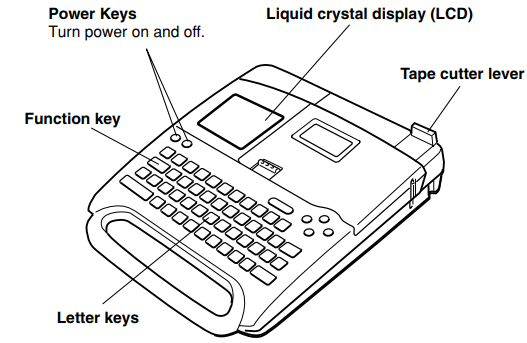
Tape Cutter Operation Precaution
Note the following important precautions when operating the tape cutter lever.
- When operating the tape cutter lever, make sure you do not press it too hard.
Always return the tape cutter lever by hand back to its original position after the tape is cut.

Back/Left Side
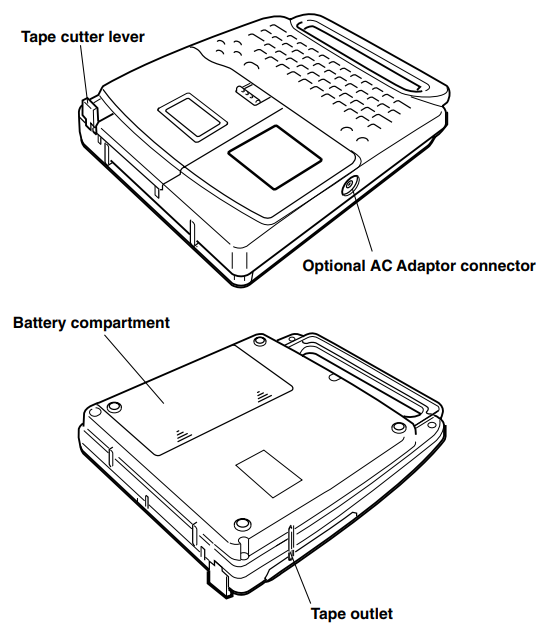
Label Printer Menus
Label Printer operation is designed to be as simple as possible, thanks to on-screen menus that you can use to select the settings you need. Each menu is described in detail in the sections that follow in this manual, but note the follow-ing general points when using them.
- The item that is underlined in a menu is the one that is currently selected.
- Use
 to move the underlining up and down and change the se-lected item.
to move the underlining up and down and change the se-lected item. - Press SET to execute the underlined item, or ESC to exit the displayed menu (and return to the previous menu or screen) without selecting anything.
- When you press SET to execute a menu item, the Label Printer either moves on to the next menu, or it executes the selected function and returns to the text input screen that you started from.

Description
Usability was a primary consideration in the development of the Casio KL-750. The built-in keyboard makes it possible to enter text in a rapid and straightforward manner, and the device's tiny form and lightweight design make it convenient to take about. The printer is capable of printing a wide variety of labels, including magnetic labels, iron-on labels, and adhesive labels, among others. After the printing process is complete, the automated label cutter ensures that the labels are cut to the appropriate size, therefore saving both time and labor.
It is also possible to examine and change label text with the printer's backlit LCD display, which makes it simple to do so even in low-light environments. In terms of both personal and professional applications, the Casio KL-750 is an outstanding instrument due to its sturdy build and dependable performance.
Getting Ready
This part of the manual tells you how to load batteries and the tape cartridge, and how to perform other basic setups for the Label Printer.
Important!
- Be sure to read this section before attempting to use the Label Printer.
Power Supply
The Label Printer can be powered by eight AA-size batteries or an optional AC adaptor (AD-A95100).
Replacing Batteries
A handy low battery power indicator lets you know when battery power is get-ting too low for proper operation. The message “BATT” appears on the display if battery power is low when you perform any of the following operations.
- Turn power on
- Execute a print operation
Whenever the “BATT” message appears, press SET to clear it from the display. You should still be able to perform some Label Printer operations, but some power intensive operations (like printing) may become impossible if battery power is too low. In any case, you should replace the batteries as soon as possible or switch to the AC adaptor as soon as possible after the “BATT” message ap-pears.
Important!
Batteries can burst or leak and damage your unit if you do not use them cor-rectly. Note the following important points.
- Be sure that the plus (+) and minus (–) sides of each battery are facing cor-rectly.
- Never mix batteries of different types
- Never leave dead batteries in the Label Printer.
- Remove the batteries if you do not plan to use the Label Printer for a long time.
- Replace the batteries at least once every 2 years.
Warning!
- Never use recharged batteries with the unit.
- Do not expose batteries to direct heat, do not short circuit them, and do not try to take them apart.
- Keep batteries out of the reach of small children. If swallowed, consult with a physician immediately.
- Be sure to replace the batteries in accordance with the battery life printed on the side of the battery itself.
To replace the batteries
- Turn power off.
If you are using the optional AC adaptor for power, you should also unplug it from the Label Printer. - Open the battery compartment cover on the back of the Label Printer by sliding it in the di-rection indicated by the arrow.
- Remove all eight of the old batteries.
- Load a set of eight new batteries into the bat-tery compartment, making sure that their posi-tive (+) and negative (–) ends are facing in the correct directions.
Replace the battery compartment cover.
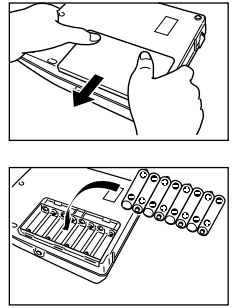
AC Adaptor
Note the following important precautions when using an AC adaptor to power your Label Printer.
- Use only a genuine CASIO AD-A95100 AC adaptor with the same voltage rating as the household current in your area. Using a wrong adaptor can damage your Label Printer.
- Be sure to turn the Label Printer off before you connect the adaptor. Do not turn power on until the adaptor is connected to the Label Printer and plugged into and AC outlet.
- Be sure to unplug the AC adaptor from the AC outlet whenever you are not using the Label Printer.
To connect the AC adaptor
Connect the adaptor to the Label Printer as illus-trated nearby. Plug the other end into a standard household AC outlet.

Turning Power On and Off
Press ON to turn power on, and OFF to turn power off.
Important!
- If you are using the Label Printer for the first time, you should reset it first.
Resetting the Memory
You should reset the memory of the Label Printer before using it for the first time, after you have not used it for a long time, or if nothing happens when you turn power on, even after you change the batteries.
Important!
- Resetting Label Printer memory clears its memory of all input data.
To reset the memory
- Make sure that Label Printer power is off.
- While holding down the PRINT and ESC keys, press ON to turn power on.
Keeping PRINT and ESC held down, release the ON key only. Press SET to initialize the Label Printer or ESC to abort the reset operation without initializing anything.
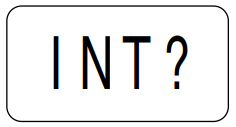
See “Initializing the Label Printer” on page 15 for information on the initial default settings of the Label Printer following the reset operation.
Auto Power Off Function
If you do not perform any key operation for about six minutes, the Label Printer automatically turns power off. To restore power, press ON.
Tape Cartridges
Use the procedures described below to load a tape cartridge into the Label Printer. After you load the tape cartridge, be sure to use the procedure de-scribed under “Tape Width Specifications” on page 6 to tell the Label Printer what is the width of the tape you are using.
Important!
- Never try to push the tape back into the cassette. Once tape is out of the cassette, there is no way to wind it back in. Trying to do so can cause opera-tional problems with the Label Printer.
To load a tape cartridge
- Make sure that the Label Printer is turned off.
- Open the tape cartridge compartment cover.
- If there is a cartridge already in the Label Printer, remove it by grasping the cartridge on both sides with your thumb and forefinger, and lift straight up.
- Remove the stopper from a new tape cartridge and check to see that the tape is ready to use.
- Make sure that the tape is under the tape guide and that it is not bent or twisted.
Make sure that the tape does not extend too far past the tape guide. If it does, cut off the end with a pair of scissors.

- Use a pencil or some other thin object to take up slack in the ink ribbon as shown in the illus-tration. Note that the tape does not move at this time.
- If the ink ribbon is slack when you load it into the Label Printer, it can break or cause some other problem.
- Be sure to turn the ink ribbon take up spool only in the direction indicated by the arrow (a).
- Turn the spool until the other spool (b) starts turn-ing in the direction noted by the arrow. This indi-cates there is no slack in the ribbon.
- Load the tape cartridge into the Label Printer, making sure that the tape and ink ribbon pass between the head and roller.
- Close the tape cartridge compartment cover.
Turn on Label Printer power and press FUNCTION and then PRINT (FEED) two or three times to make sure that the tape comes out without any problem.
If the tape does not come out normally, turn off power and start again from step 1 above.
Tape Width Specification
Important!
- When using 6mm tape, using certain character sizes can cause characters to run off the top or bottom of the tape. Be sure to use the following procedure to tell the Label Printer when you are using 6mm tape.
To specify 6mm tape width
- Turn power on.
- Press FUNCTION and then 9 (6mm).
- Press
 to change the setting shown on the display between ON (6mm tape) and OFF (other tape width).
to change the setting shown on the display between ON (6mm tape) and OFF (other tape width). - When the tape width setting is the way you want it, press SET to register it.
- The tape width you set remains in effect until you change it or reset the Label Printer’s memory.
Inputting Characters and Symbols
This part of the manual tells you how to input characters. To make things easier to understand, we call everything you input a character, regardless of whether it is actually a letter, number, or symbol. Explanations here all use the default settings that are in effect from the initial power-on screen.
Important!
- You can input up to 63 characters per label. Further input becomes impossi-ble after you input the 63rd character.
Display Symbols and Indicators
Before getting into actual input, you should first become acquainted with the symbols and indicators used on the Label Printer display.

Function indicator
This indicator appears when you press the FUNCTION key. Pressing a key while this indicator is on the display causes the function marked above that key to be executed.
Shift indicator
This indicator appears when you press the SHIFT key. While this indicator is on the display, the keyboard is shifted, so the letter keys input upper-case alpha characters. The number keys input the punctuation symbols marked in the up-per right corners of the keys.
If both the caps mode indicator and the shift indicator are shown on the display, the keyboard is shifted to lower-case input.
The keyboard automatically unshifts (and the shift indicator disappears) as soon as you input a character.
Code indicator
This indicator appears when you press the CODE key. While this indicator is on the display, number keys 1 through 5 input the accents marked above them and the O, S and C keys input the special characters marked in their lower right corners.
The keyboard automatically returns to normal (and the code indicator disap-pears) as soon as you input an accent.
Caps indicator
This indicator appears when the Label Printer is in the caps (upper-case) mode. All letters you input in the caps mode are upper-case. When the caps mode indicator is not shown on the display, all letters are input as lower-case. Note that the Label Printer stays in the caps mode until you press the CAPS key again.
If both the caps mode indicator and the shift indicator are shown on the display, the keyboard is shifted to lower-case input.
Effect indicators
These indicators point to the character effect that is currently in use. You can select between shading, underline, and box.
Stamp printing indicator
This indicator appears when the Label Printer is set up for stamp printing. La-bels you create with stamp printing can be attached to an optionally available stamp holder and then used as a pre-inked stamp.
Mirror image printing indicator
This indicator appears when the Label Printer is set up for mirror image printing. Normal (non mirror image) printing is performed when this indicator is not shown.
Manual feed indicator
This indicator appears when you are using manual feed instead of auto feed. Auto feed is in effect when this indicator is not on the display.
Important!
- After you finish printing when using manual feed, be sure to always press FUNCTION and then PRINT (FEED) to feed the tape before cutting it. If you don’t you will cut off part of the printed text.
- 6mm tape indicator
This indicator appears when you use the procedure on page 6 to specify you are using 6mm tape. No indicator is shown when you are using other (9mm, 12mm, 18mm) tape. - Cursor
The cursor shows the next input position. Any character you input appears at the point where the cursor is located. - Character position marks
These marks show where characters will appear as you input them. This part of the display is always blank when you turn power on.
Basic Alpha-Numeric Input
The following operation shows you the basic procedures for inputting letters and numbers. We will explain the procedure by inputting the following charac-ters using the default initial power-on screen.
ABXYZ Computer Company 1234567890
Note: If you hold down any key, it will repeat its operation or input at high speed until you release it.
To input alpha-numeric characters
- Turn power on.
- Input the first line of characters.
- To input the upper-case letters, you can use either SHIFT or CAPS. With SHIFT you must shift the keyboard for each character. With CAPS the key-board stays in upper-case until you press CAPS again.
- Press SPACE to input spaces.
- If you input a wrong character, press BS to delete it and input again. See page 9 for other details on editing text.
- When you reach the end of a line of text, press
 (the
(the  cursor key) to input a newline mark.
cursor key) to input a newline mark.- A newline operation is indicated on the display by the
 symbol. This shows where you changed lines.
symbol. This shows where you changed lines.
- A newline operation is indicated on the display by the
- Input the characters in the second line.
- To print the text that you input, press PRINT. For details on printing, see page 11.
About the CODE key…
The CODE key makes it possible to input punctuation needed for a number of different languages. The following shows the key operations you should use for each of the characters formed using the CODE key.
| Key Operation | Input | Key Operation | Input |
| CODE S* | ß | CODE 2 | ` |
| CODE O | Œ | CODE 3 | ¨ |
| CODE C | Ç | CODE 4 | ˜ |
| CODE 1 | ´ | CODE 5 | ˆ |
Lowercase only.
Example: To input á.
- CODE 1 A
Special Symbols
You can also access a menu of special symbols by pressing FUNCTION 4 (SYMBOL).
To input special symbols
Example: To input the special symbol #.
With the cursor at the location where you want to input a special symbol, press FUNCTION 4 (SYMBOL).
The symbol that is underlined on the display is the one that is currently selected.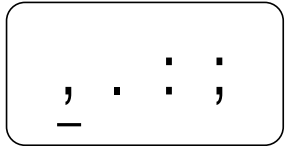
- Use the H and J cursor keys to move the underlining to the symbol you want.
- Not all of the available symbols fit on the display. The menu will scroll when you press the cursor keys.
- In this example, underline #.
After you underline the symbol you want, press SET.
This returns to the input screen, with the symbol you selected input at the location where the cursor was located when you displayed the symbol list.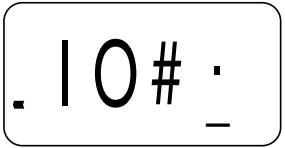
Deleting and Inserting Characters
This section describes everything you need to know about deleting and editing characters you have already input.
Moving the Cursor
Use the cursor keys to move the cursor around the display and position it for deleting and editing characters.
To move the cursor
- Press
 to move the cursor to the left, and
to move the cursor to the left, and  to move the cursor to the right.
to move the cursor to the right. - Press FUNCTION and then
 to make the cursor jump to the beginning (far left) of the characters on the display.
to make the cursor jump to the beginning (far left) of the characters on the display. - Press FUNCTION and then
 to make the cursor jump to the end (far right) of the characters on the display.
to make the cursor jump to the end (far right) of the characters on the display. - Holding down the
 cursor key moves the cursor at high speed.
cursor key moves the cursor at high speed.
Deleting Individual Characters
You can delete individual characters with either the BS key or the DEL key (which is the ![]() cursor key). The only difference between the operation of these two keys is the location of the cursor.
cursor key). The only difference between the operation of these two keys is the location of the cursor.
To delete characters using the BS key
Example: To change the word “computer” to “computer”.
Use
 to move the cursor under “p”.
to move the cursor under “p”.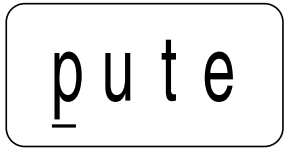
- Press BS twice to delete the two m’s to the left of the cursor, shifting “puter” to the left as you do.
- Press FUNCTION and then
 to jump back to the end of the characters for more input.
to jump back to the end of the characters for more input.
To delete characters using the DEL key
Example: To change the word “commmputer” to “computer”.
- Use
 to move the cursor under the first (far left) “m”.
to move the cursor under the first (far left) “m”. - Press DEL twice to delete the two m’s at the cursor’s position, shifting “mputer”to the left as you do.
- Press FUNCTION and then
 to jump back to the end of the characters for more input.
to jump back to the end of the characters for more input.
Clearing the Display
Use the following procedure to clear all input text from the display.
To clear the display
- Press FUNCTION and then BS (CLS).
- At this time the message CLS? appears on the display to confirm that you want to clear the display. Press SET to clear or ESC to abort the operation without clearing anything.
Text Editing
You can use the following procedures to edit text on the display.
To insert new characters
Example: To change the text “ABCDEF” to “ABCXYZDEF”.
- With the original text on the display, move the cursor under the letter “D”.
- Input the new characters (XYZ).
Inputting the new characters causes them to be inserted at the cursor posi-tion. The existing characters are opened up to make room for the new char-acters.
To change existing characters to different ones
Example: To change the text “ABCDEF” to “XYZDEF”.
- With the original text on the display, use either the BS key or DEL key to delete the characters to be changed (ABC).
Remember to use the correct cursor location for the key you plan to use to delete the characters. - Input the new characters (XYZ).
Character Size and Text Effects
This part of the manual explains how to change the size of characters. It also tells you how to assign text effects like underlining, shading, and box printing.
Character Size
The following table shows the six character sizes that are available.
| Character Size Indicator | Actual Size (mm) |
| 1´1 | 3´3 |
| 1´2 | 3´6 |
| 1´3 | 3´9 |
| 2´1 | 6´3 |
| 2´2 | 6´6 |
| 2´3 | 6´9 |
Character size changes are applied to printed text only. The size of the dis-played text does not change.
Important!
- Any character size specification you make is applied to all the characters on the display. You cannot make multiple specifications for specific characters.
- The Label Printer automatically adjusts the character size whenever you in-put a ¥ symbol to create a 2-line label as shown below.
| Initial Size | Size After B Operation |
| 2´1 | 1´1 |
| 2´2 | 1´2 |
| 2´3 | 1´3 |
Note that you cannot input a ¥ symbol if you are using 6mm wide tape.
To change the character size
Example: To input “ABXYZ” as 2×2 characters.
- Input the text.
Press FUNCTION 2 (SIZE) to display the cur-rent character size setting.
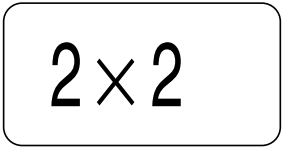
Use
 to change the displayed size in the following sequence.
to change the displayed size in the following sequence.
When the character size you want to specify is on the display, press SET to select it and return to the text display.
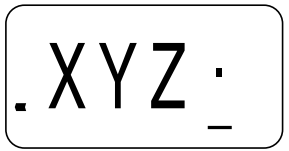
Note: You could also perform the above procedure in reverse, specifying the char-acter size first and then inputting the text.
Text Effects
There are three text effects that you can assign: shading, underlining, and boxed text. The following shows examples of each.

Text effect changes are applied to printed text only. The appearance of the displayed text does not change, but the text effect indicators will show you when a text effect is being used.
Important!
- Any text effect specification you make is applied to all the characters on the display. You cannot make multiple specifications for specific characters.
To specify a text effect
Example: To shade the text “ABXYZ”.
- Input the text.
Press FUNCTION 3 (EFFECT) to display a menu of text effects.

- Use
 to move the cursor to the effect you want to use.
to move the cursor to the effect you want to use. When the cursor is located under the effect you want to specify, press SET to select it and re-turn to the text display.
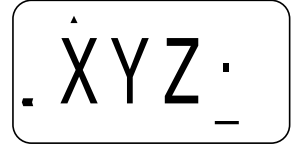
Note
- You could also perform the above procedure in reverse, specifying the text effect first and then inputting the text.
Printing
This part of the manual includes all the information you need to print tapes. It also tells you how to print special stamp tapes that you can attach to an optional stamp holder to create your own original stamps.
Printing Precautions
- Never turn power off while printing is being performed.
- Make sure that the tape outlet is not blocked before you start printing.
- Never operate the tape cutter while printer is being performed (indicated by the message “PRNT” on the display).
- During printing at very high density, printing of very long text, or repeat print-ing of the same text a number of times, the Label Printer may stop printing for about five seconds. This is not a malfunction, and normal printing should resume shortly (indicated by the message “P R N T” on the display).
Printing a Tape
Printing a tape is as easy as pressing the PRINT key.
To print a tape
- Press the PRINT key to print a tape of the text you have input and laid out.
- To stop a print operation that is in progress, press ESC.
- After the print operation is complete, press down on the tape cutter lever to cut the tape.
- Use scissors to trim the tape to the size you want, if necessary.
- After you print a tape, you can peel off its paper backing and stick the tape onto the object you want. Note that the tape will not stick on coarse, wet, oily, or soiled surfaces. Also, you should not try to use the tape where it is exposed to direct sunlight or rain. Do not stick the tape onto hu-man skin.
An easy way to remove the backing from a tape and expose the adhesive surface is to bend the tape near one of its ends. This should cause the tape and its backing to separate, allowing you to pull them apart.
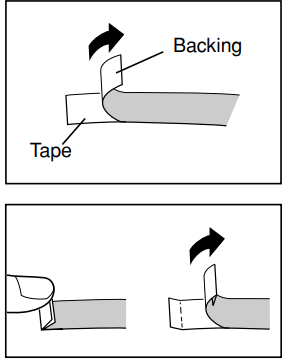
Stamp Printing
The stamp printing feature lets you print on special stamp tape. You can then attach the finished stamp tape to an optionally available stamp holder to create your own original pre-inked stamps. The following is the type of stamp holder currently available for use with stamp tapes.
| Type | Maximum Stamp Size | Example |
| ST-15 | 5.5cm |  |
Note the following important points about stamp printing.
- Stamp printing prints text in mirror image.
- Stamp printing is impossible while 6mm is specified as the tape width.
- An error message (ERR!) appears on the display and the Label Printer refuses to print whenever you try to print text that is longer than the maximum length you specify.
To print a stamp tape
- Input the text you want to print.
Press FUNCTION and then 5 (STAMP).

- A mark appears next to the STAMP indicator on the display when mirror printing is turned on.
- If the text you input in step 1 is too long to fit within the maximum length you specified, an error message (page 16) appears when you press SET.
- Press SET to print the stamp tape or ESC to abort the print operation and return to the text input display in step 1.
- After the printing is complete, the Label Printer returns to the input display in step 1.
- Cut off the tape and affix it to the optional stamp holder.
- See the instructions that come with the optional stamp holder for information about how to attach the stamp tape.
Mirror Image Printing
When you specify mirror image for text, it is printed in reverse image. Use mirror image when you plan to print on transparent tape, with the printing on the inside. When viewed through the transparent tape, the text will appear normal. You can also use mirror image printing when using iron-on transfer tape to print iron-on transfers.

To turn mirror image printing on and off

- Press FUNCTION and then 6 (MIRROR).
- Press
 to change the setting shown on the display between ON (mirror printing) and OFF (normal).
to change the setting shown on the display between ON (mirror printing) and OFF (normal). - When the mirror image printing setting is the way you want it, press SET to register it.
- A mark appears next to the MIRROR indicator on the display when mirror printing is turned on.
- After you turn printing on, input text and perform the print operation as you normally do (page 11) to produce mirror image tapes.
Other Printing Features and Operations
The following are other operations and settings that you may need to use when printing.
Auto Feed
You can turn the Label Printer’s auto feed feature on and off. When auto feed is on, the Label Printer automatically feeds the tape about 12mm at the beginning and end of each print operation. This creates identical margins on both sides of your text.
Important!
- After you finish printing when using manual feed, be sure to always press FUNCTION and then PRINT (FEED) to feed the tape before cutting it. If you don’t you will cut off part of the printed text.
To turn auto feed on and off
Press FUNCTION and then 7 (M-FEED).

- Press
 to change the setting shown on the display between YES (manual feed) and NO (auto feed).
to change the setting shown on the display between YES (manual feed) and NO (auto feed). - When the feed setting is the way you want it, press SET to register it.
To manually feed tape
Press FUNCTION and then PRINT (FEED) to feed the tape 13mm.
Print Density
The print density setting controls how darkly figures are printed on your tapes.
To adjust the print density
Press FUNCTION and then 8 (DENSITY).
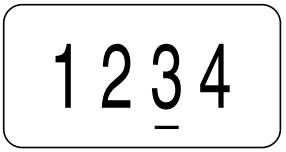
- Use
 to move the underlining to the density setting that you want.
to move the underlining to the density setting that you want.- The lightest setting is 1, while the darkest setting is 5. The standard setting is 3.
- Only four of the five settings that are available can appear on the display. The display scrolls left and right when necessary to shows all of the available settings.
- When the density setting is the way you want it, press SET to register it.
Memory
This part of the manual tells you how to store text data in memory for instant recall when you need it. You can store two blocks of text in memory, each con-taining up of 63 characters, for a total of 126 characters.
To store data
- Input the text you want to store.
- Press FUNCTION and then 1 (MEMO).
- Press SET to store the text in memory or ESC to abort the store procedure without storing anything.
- If there is nothing in memory yet, your text is automatically stored in Area 1. If Area 1 already contains data, your new input is automatically stored in Area 2.
If there is not enough room for your text to fit in memory, the message “FUL!” appears when you press SET in step 3.
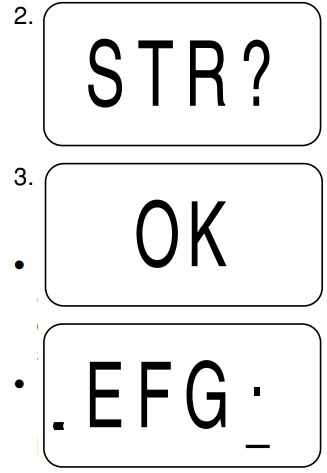
To recall text from memory
Example: To recall the contents of Area 2 while memory contains the following text.
Area 1: ABCDEFG
Area 2: CASIO
- While the input screen is on the display, press FUNCTION and then 1 (MEMO).
Note that text recalled from memory will replace any text currently on the display.

- Press
 to change to the text recall prompt.
to change to the text recall prompt. - Press SET.
- If all of the text does not fit on the display, you can use
 to scroll it to the left and right.
to scroll it to the left and right.
- If all of the text does not fit on the display, you can use
- Press
 to change to Area 2.
to change to Area 2.- Use
 to switch between Area 1 and Area 2.
to switch between Area 1 and Area 2.
- Use
- Press SET to recall the text from the area that is currently on the display.
Note that recalling data from memory replaces anything that is currently on the input display. Memory text cannot be appended.
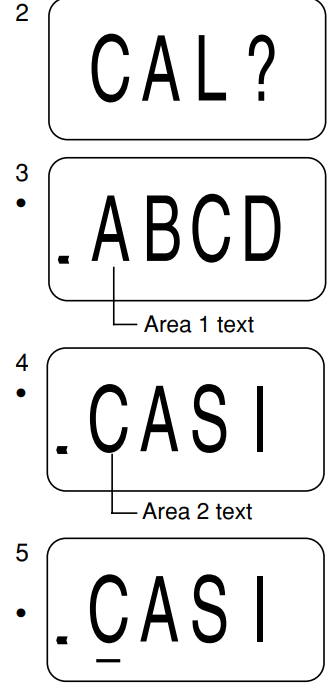
To delete text from memory
- While the input screen is on the display, press FUNCTION and then 1 (MEMO).
Press
 twice to change to the text delete prompt.
twice to change to the text delete prompt.
- Press SET.
If all of the text does not fit on the display, you can use to scroll it to the left and right.
to scroll it to the left and right. Use
 to select Area 1 or Area 2 then press SET.
to select Area 1 or Area 2 then press SET.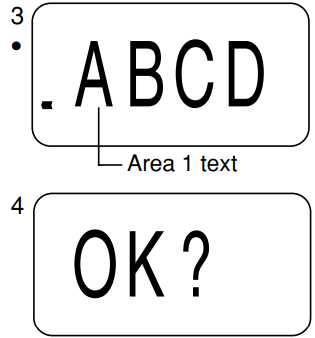
- Press SET to delete the text from the area that is currently on the display.
Reference
This section contains information about the Label Printer that you can use as reference when you need it.
Replacing the Tape Cutter Blade
The tape cutter blade is designed to provide approximately 3,000 cuts. Use the following procedure to replace the blade whenever it starts to cut poorly.
To replace the tape cutter blade
- Make sure that the Label Printer is switched off.
Open the tape cartridge compartment cover.
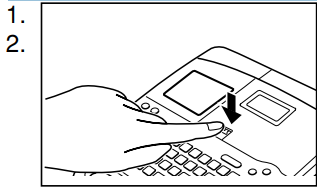
- If there is a cartridge already in the Label Printer, remove it by grasping the cartridge on both sides with your thumb and forefinger, and lift straight up.
- Use a thin, pointed object to lift the yellow cutter cartridge out of the Label Printer as shown in the illustration.
- The tape cutter blade comes out of the cutter cartridge if you press on the front of the cartridge. Be sure to take care to avoid cutting your fingers on the blade.
- Install a new cutter cartridge by sliding it along the groove provided in the Label Printer.
- Contact your CASIO dealer to purchase a re-placement cutter cartridge.
Replace the compartment cover.
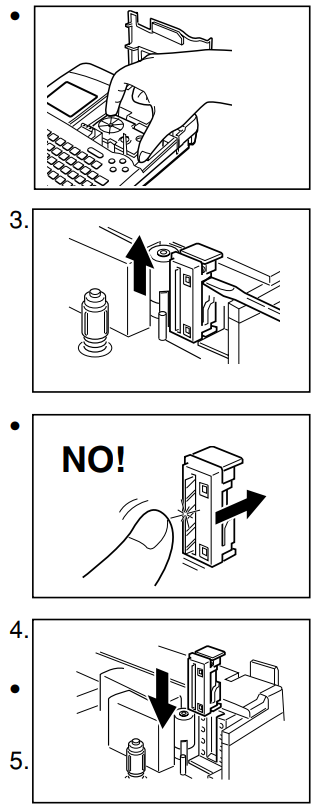
Cleaning the Printer Head and Roller
A dirty printer head and roller can result in poor printing quality. If you have problems with print quality, use the following procedure to clean the printer head and roller.
To clean the printer head and roller
- Make sure the Label Printer is turned off.
- Press the tape cartridge compartment cover release and open the compart-ment cover.
- Remove the tape cartridge.
- Use a cotton swab dipped in alcohol to clean the printer head and roller as shown in the illus-tration.
Replace the tape cartridge and close the compartment cover.
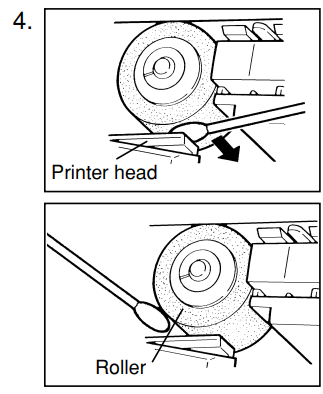
Initial Power On Settings
The following are the initial settings of the Label Printer whenever you turn it power on.
| Item | Power On |
| SIZE | 2´2 |
| EFFECT | CANCEL |
| MIRROR | OFF |
| M-FEED | NO |
| 6mm | OFF |
Initializing the Label Printer
If you experience serious malfunction of the Label Printer or if operation fails completely, try performing the following operation to initialize the printer.
Important!
- Initializing the Label Printer deletes all memory contents. Make sure you have a back-up copy of text stored in memory if you need it.
To initialize the Label Printer
- Turn power off.
While holding down the PRINT and ESC keys, press ON to turn power on.

- Keeping PRINT and ESC held down, release the ON key only.
This prompt confirms whether or not you want to initialize the Label Printer. - Press SET to initialize the Label Printer or ESC to abort the reset operation.
The following table shows the initial settings.
| Item | Reset |
| Display | Cleared |
| Memory | Cleared |
| SYMBOL | , |
| EFFECT | CANCEL |
| M-FEED | NO |
| MIRROR | OFF |
| MEMO | STR? |
| DENSITY | 3 |
| WIDTH | OFF |
Setup Guide
Setting up the Casio 2 Line Label Printer KL-750 is straightforward:
- Insert the batteries (4 AA batteries) into the battery compartment.
- Load the label roll into the printer according to the manufacturer's instructions.
- Turn on the printer using the power button.
- Use the built-in keyboard to input your label text.
- Select the desired label size and formatting options using the navigation buttons.
- Press the print button to print your label.
Troubleshooting
| Problem | Possible Cause | Action |
| ERR! message on the display. | · Attempt to input two ¥ marks within the same text.
· Attempt to input ¥ mark while 6mm is specified as the tape width.
· Label text containing a ¥ mark was input and then tape width specification was changed to 6mm. (ERR! message appears when you try to perform a print operation.) · Text that is longer than 5.5cm when stamp printing is selected. · Attempt to print a stamp while 6mm is specified for the tape width. | · Use only one ¥ mark. Only two lines of text can be input, so text can contain only one ¥ mark. · Do not use ¥ marks. 6mm tape can have only one line of text, so text cannot contain any ¥ marks. · Delete the ¥ mark to print on 6mm tape or switch back to a wider tape.
· Shorten the text to be printed and try again.
· Change the tape width setting to OFF and try printing the stamp again. |
| FUL! message on the display. | · Both text memory areas (AREA 1 and AREA 2) already contain text. | · Delete text from one of the text memory areas and then store the new text. |
| BATT message on the display. | · Battery power is too low. | · Replace batteries. |
| ERR! message on the display. | · Memory data has become corrupted for some reason. | · Initialize the Label Printer. |
Casio 2 Line Label Printer KL-750 Pros & Cons
Pros
- Portable and lightweight design
- Easy to use with a built-in keyboard
- Supports various label sizes and types
- Automatic label cutter for convenience
- Backlit LCD display for better visibility
- Memory storage for up to 50 label templates
Cons
- Battery life may vary depending on usage
- Limited to printing two lines of text per label
- No wireless connectivity option
- Label costs can add up over time
Customer Reviews
Casio KL-750 users have, on the whole, expressed their satisfaction with the device's user-friendliness and dependability. The fact that it is portable and supports a wide range of label sizes is something that a lot of customers like. On the other hand, a few customers have mentioned that the battery life should be improved, and that the purchase of labeling can be a recurrent expense.
Common complaints
Make sure to take into account the absence of wireless connectivity as well as the restriction of only two lines of text per label. In spite of this, the generally accepted opinion is that the Casio KL-750 is an excellent option for meeting the requirements of simple labeling.
Faqs
What are the main uses of the Line Label Printer?
How do I load labels into the Label Printer KL-750?
Can I use different types of labels with the Casio?
How long does the battery last in the 2 Line?
Is the Casi easy to set up?
Can I store label templates on the 2 Line Label Printer?
How do I cut labels with the Casio 2 Line Label Printer KL-750?
Is the Casio suitable for high-volume labeling?
Can I use the Casio in low-light conditions?
Leave a Comment
